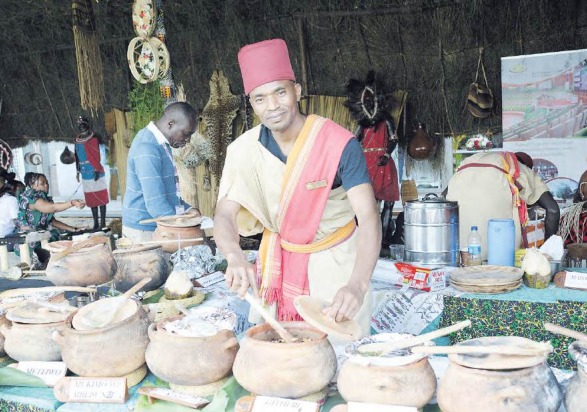
By JACKTONE LAWI
On Thursday, a Maasai man carrying nice leather belts decorated with beads and handwoven leather sandals approached this writer.
He was selling his wares at an average of Sh800. Upon bargaining, they settled at Sh500.
“I’m not sure if I’ll make any sales today, so let me just accept your cash, but I will not have made any profit,” Kapalei Logan said.
The short engagement opened me up to a larger conversation on how handcrafted artisans, despite putting in more labour and time in making their wares, still fail to get value for their input.
The tough economy is forcing artisans to settle for little to cater to basic household needs in a classic hand-to-mouth scenario threatening to sink the once-promising JuaKali Industry.
According to the Kenya Economic Survey Report 2023, the Jua Kali sector contributed 25 per cent of the GDP, a similar contribution rate to that of agriculture.
“The role of the Jua Kali sector in the economy cannot be underestimated, apart from creating jobs, Jua Kali products are exported to the neighboring counties thereby fetching foreign exchange for the economy,’’ Kenya National Chamber of Commerce and Industry (KNCCI) President Erick Rutto said during the launch of the first-ever Jua Kali sector strategic plan 2022-2027.
The home décor and handicrafts industry, a section of the Jua Kali sector, remains informal with no much-needed attention from the government despite providing a lot of employment opportunities for thousands of Kenyan youth.
The country hosts some of the most celebrated handcrafters, ranging from Nubian women who ply their trade in Kibera, Maasai women weaving baskets in Kajiado, Kitenge makers in Mombasa, artisans in Narok making their craft from wood carvings and from Kambas from Makueni who have specialised in curvings from limestones.
To safeguard the artisans from exploitation by middlemen, the social enterprise organization - Powered by People is training the unskilled artifact makers with registered businesses on how to add value to their products and price them right.
The organisations co-founder, Hedvig Alexander, says that to address this challenge, they have unveiled a new initiative in Kenya to help artisans expand their reach to global markets and increase the value of their products.
This will see the organisation train local artisans and small scale producers from Kenya and link them up with global markets, particularly in North America and Europe.
“We wanted to create this event to help local producers connect with buyers and see how they can scale up. The event not only attracts international buyers but also encourages local participation, highlighting the importance of Kenyan craftsmanship,” said Alexander.
Powered by People community and engagement manager, Robert Mwehe, who spoke in Nairobi during an expo that brought together artisans from across the country, said one of the key issues of concern is the exploitation of less experienced artisans by intermediaries.
“We introduced digital catalogs that allow artisans to display their products and set prices directly, providing them with more control and reducing the likelihood of exploitation,” said Mwehe.
He noted that these efforts are designed to make handmade products—like woven baskets and vases—more visible and accessible in global markets.
Despite these efforts, he acknowledged that more needs to be done to create a legal framework that protects artisans and allows them to maximise the potential of their craft.
For instance, one of the challenges that the engagement is looking to address is the disparity in pricing for similar products, depending on where they are made.
In addition to pricing, the program also aims to improve artisans’ ability to tell the stories behind their creations, which has become increasingly important to international buyers.
“Buyers want to know the story behind the product – where it came from, how it was made, and the impact it has on the artisan’s community,” Mwehe added.
An advocate for Made in Kenya and the artisan sector in Goodie Odhiambo says that the handcraft industry is yet to be understood.
“The artisan sector is very complex because every product has its raw materials for every product. All we can do is educate the artisans to improve the quality and learn as they engage with the buyers on what’s the right prices,” said Odhiambo.
“We are using this platform to be able to educate them such that they don’t just have to look for a product and decide this is the price, they have to be able to justify how they came to the pricing,” she added.
By improving product quality and market access, the initiative aims to elevate Kenyan craftsmanship on the global stage and create a sustainable circular economy.
Plans for the future include customising products to meet the needs of local lodges and oare protected and their goods are priced fairly.
“We aim to support artisans at every level,” said one of the project leaders.
“From traditional masks to jewelry, leather products, shoes, and bags, we have a wide range of offerings ready for international markets,” said Alexander.
To tackle this issue, the organization has implemented a training program for artisans focusing on product development, quality control, and pricing strategies.
Mwehe emphasized the importance of teaching artisans how to factor in the cost of materials, labour, packaging, pricing, and shipping to meet international standards to arrive at a fair price for their products.
The programme is designed to support artisans from all skill levels, including refugees and people with disabilities, by connecting them with opportunities to showcase their handmade goods.
A key focus of the initiative is to formalise and promote the artisan sector, which has been largely overlooked despite its significant contribution to the Kenyan economy.
Training programs have already reached over 8,000 women, focusing on product quality, costing, pricing, and storytelling.
The initiative also provides artisans with low-interest financing to purchase raw materials for their orders.
It also provides low-interest loans to businesses, helping them grow and expand.
Over the past two years, the initiative has generated over $1 million in exports for Kenyan artisans, reaching approximately 50 companies and impacting over 28,000 people.
Alexander said they have been engaging grassroots organizations, Kenya National Chamber of Commerce and Industry (KNCCI) and the Kenya Private Sector Alliance (KEPSA) to drive training and capacity-building efforts.
It is estimated that formalising the artisan sector it will unlock the vast potential of the global handmade market, which is valued at around $1 trillion (Sh129 trillion).
The enterprise’s goal is to expand its reach to 3,500 micro-businesses and SMEs in the coming years through financing and digitalization efforts, supporting artisans in becoming self-sustaining and globally competitive.
















